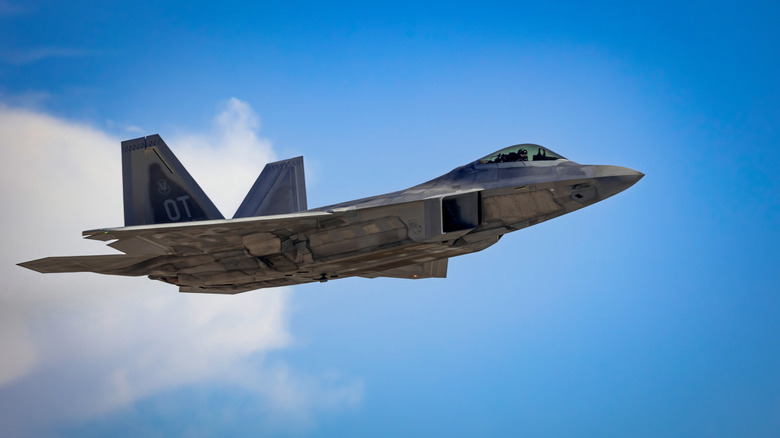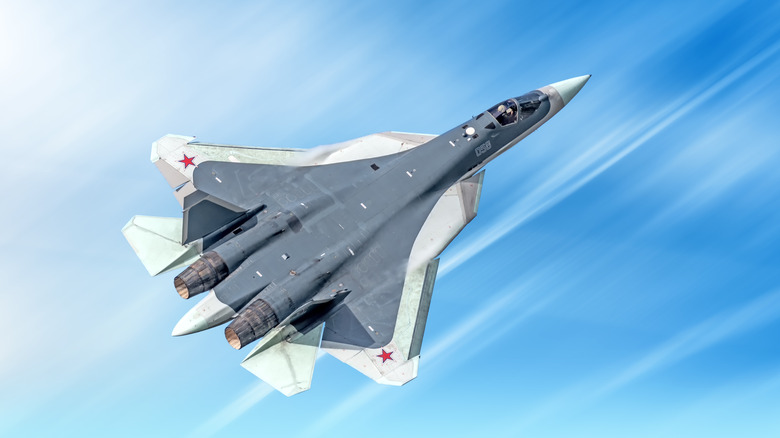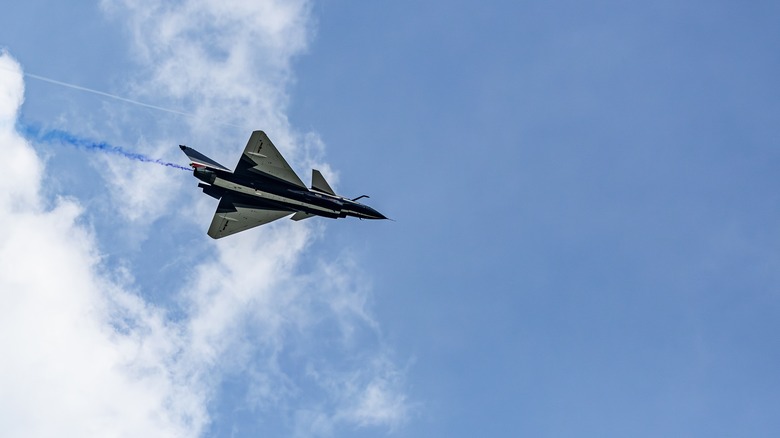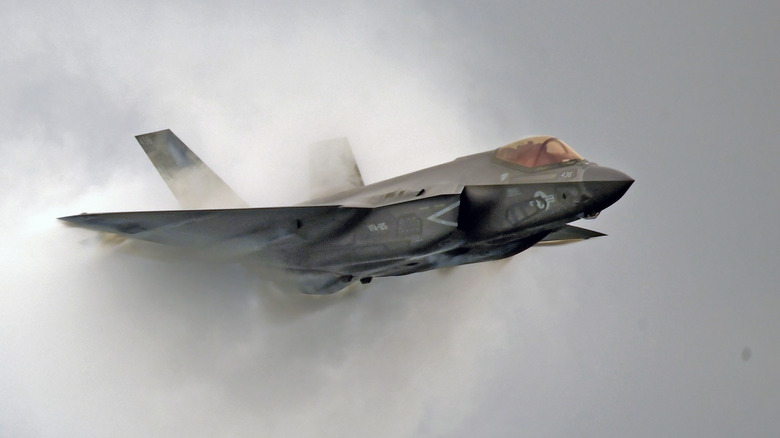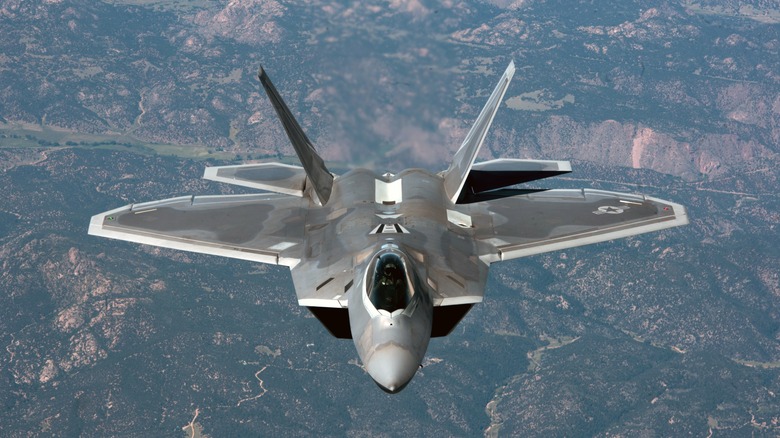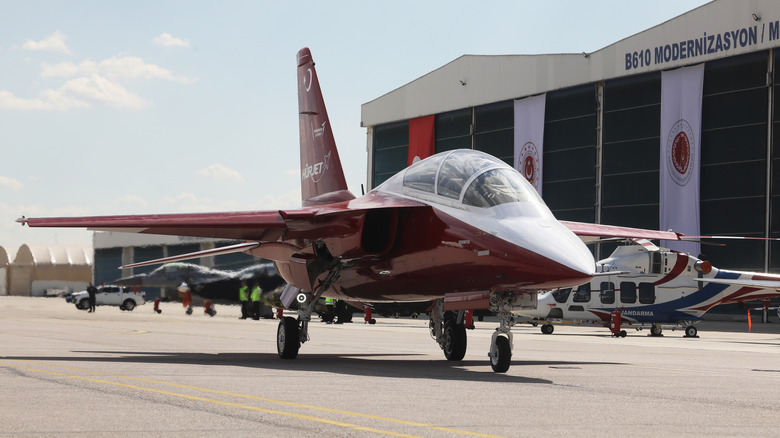Every 5th-Generation Fighter Jet Operational In 2024
When people think about fighter jets, they are unlikely to think in terms of different generations. Although many individuals will be aware that some operation fighters are more modern and advanced than others, it isn't common knowledge to know that there's a classification system built around the capabilities and technology included in the aircraft.
The first generation of fighter jets emerged at the end of the Second World War. These primitive fighters were designed solely to strike enemy aircraft and gain air superiority. These evolved into the faster fighter jets of the second generation, which were capable of firing homing missiles. By the time that third-generation fighters emerged, the aircraft had to fulfill a number of roles, such as reconnaissance, air-to-air combat, and aerial bombing.
Today, the vast majority of military forces around the world have fourth-generation fighters. These were created during the 1980s and are highly maneuverable, able to carry out a wide array of duties. Examples include the Eurofighter Typhoon, the Dassault Rafale, and the infamous F-15. However, there are a small number of fifth-generation fighters in active service today and a lot more on the way as the older fighter jets get phased out.
Sukhoi Su-57
In many ways, it makes perfect sense that Russia would have its own fifth-generation fighter. After all, the country still maintains a somewhat frosty relationship with the U.S. and tries to maintain an equal footing wherever possible when it comes to technology and combat capabilities. Unlike the U.S., which has two fifth-generation fighters, Russia currently takes the same approach as its ally China by having just one operational aircraft that fits into this category.
The Sukhoi Su-57 Felon jet has an impressive set of specs. Able to climb to 65,000 feet, the Su-57 has a higher operational ceiling compared to the F-22. It can also reach a top speed of around Mach 2 (roughly 1,550 mph) and can remain in the air for up to 2,175 miles. It is also armed with a wide range of weaponry, from missiles and rockets to a powerful autocannon.
Russia intends for this fighter to replace both the MiG-29 and Su-27, operating as a multirole fighter with stealth capabilities like most other aircraft of this type. That makes it more akin to the F-35 and J-20 than the F-22, which is primarily an air superiority fighter. Among the nations that have fifth-generation fighters, Russia currently has the least amount, The Su-57 first flew in 2010 and since its introduction into active service in 2020, only 22 production units have been manufactured and delivered.
Chengdu J-20
In recent years, China has been rapidly expanding its air capabilities and nowhere is this more apparent than with the launch of its Chengdu J-20 jet fighter. Also known as the Mighty Dragon, the Chengdu J-20 is intended to be an air superiority fighter with stealth elements that can rival the F-22 Raptor, which is currently in service with the United States Air Force. Making its debut flight in 2011, the J-20 subsequently entered service in 2017 and more than 150 have since been built.
Development of the Mighty Dragon can be traced back all the way to the 1990s, but plans were only really put into motion in the early 2000s. Aided by stolen plans for both the F-22 and F-35, China was able to manufacture a fifth-generation fighter among the most capable in the world today. In fact, it comes with an array of stealth systems and technologies to help it avoid radar pings. This includes absorbent materials and a large collection of sensors and advanced communication capabilities.
The J-20 is also one of the fastest fighters ever made, able to reach a top speed of Mach 2.55. That means it can travel at 1,650 mph, although only for a limited amount of time. A new variant of the J-20 looks set to make use of a more powerful and efficient WS-15 engine, which may allow it to maintain its top speed for longer durations.
Lockheed Martin F-35 Lightning II
The Lockheed Martin F-35 Lightning II is the United States' most up-to-date fifth-generation fighter jet, capable of fulfilling many of the same roles as the F-22 Raptor at a fraction of the price. The multirole fighter doesn't have the same kind of stealth capabilities as its earlier cousin but it is still a significant upgrade on the aircraft that other nations can call upon for their air forces. Again developed by Lockheed Martin, with some assistance from Northrop Grumman and BAE Systems, the first flight for the fighter was in 2006 and it entered active service in 2015.
Unlike the F-22, the F-35 has been exported to a wide range of countries and is in operation with the likes of Australia, Canada, Japan, and the United Kingdom. More than 1,000 Lighting IIs have now been built and many more are planned for the next decade or so. It is capable of carrying out everything from strike missions against ground targets to performing surveillance and reconnaissance over enemy territory.
The speed and range of the F-35 make it stand out as one of the best fighters in the world. The Pratt and Whitney turbofan engine can produce up to 43,000 pounds of thrust and allow it to reach speeds of Mach 1.6 (equivalent to 1,185 mph). The F-35 is also equipped with state-of-the-art stealth components that hide it from radar and make it difficult to detect. Meanwhile, the short take-offs and vertical-landings allow it to operate from aircraft carriers. This makes the Lightning II even more versatile.
Lockheed Martin F-22 Raptor
Although the Lockheed Martin F-22 Raptor isn't exactly a new aircraft, with it first flying some 26 years ago in 1997, it remains one of the most advanced fighters ever created — especially in terms of stealth and maneuverability. The F-22 has a lot of strengths that make it stand out from the fighters fielded by almost any other nation. Development began on the Raptor during the 1980s, with the aircraft intended to replace earlier jets the F-15 in the U.S. Air Force. Lockheed Martin was responsible for the vast majority of the design and manufacturing process, although Boeing also collaborated on some of the parts and systems.
As a fifth-generation fighter, the F-22 is designed to be able to carry out a wide array of roles, including establishing air superiority, performing ground attacks, and being used in electronic warfare and intelligence gathering. Meanwhile, its reduced airframe and carbon fiber composite structure ensure it is lightweight and harder to detect, with the fighter having a smaller cross section that emits less sound and radio waves.
The U.S. government initially wanted more than 750 F-22s in its arsenal but the excessive cost — upward of $350 million per unit — meant this was ultimately reduced to just 186. This is because it used cutting edge technology and was groundbreaking when it entered service in 2005. After all, it is able to reach Mach 1.5 without engaging its afterburners and is armed with AIM-9 Sidewinders and a M61A2 gun. It is little wonder, then, that no F-22 Raptors have ever been exported to a foreign country.
Upcoming Fifth Generation Fighters
Although only China, Russia, and the United States have their own fifth-generation fighter jet programs, other nations are developing their own projects rather than relying on importing aircraft from these countries. One of the most advanced of these is Turkey's TAI TF Kaan. A joint collaboration between Turkish Aerospace Industries and BAE Systems, the aircraft will ultimately replace the F-16 fighters that currently make up the majority of the Turkish Air Force. A prototype of the TF Kaan performed ground tests in 2023 and the first test flight for the fighter occurred in February 2024. However, it is not expected to enter full production and go into active service until the 2030s at the earliest.
India is another nation with a fifth-generation fighter development program. The HAL AMCA is in the very early stages of the design process. In fact, it was only in March 2024 that the Indian government approved spending for a prototype to be created. The aircraft is intended to have two variants, with the second later version incorporating sixth-generation technology such as hypersonic weapons.
Some countries are also working on sixth-generation fighters. Japan is developing a futuristic next-generation jet fighter known as the Global Combat Air Programme. This is a joint project with Italy and the U.K. that combines the previous Tempest and Mitsubishi F-X programs that were previously in development with BAE Systems and Mitsubishi. This aircraft will not enter service until 2035, when it will replace the Eurofighter Typhoon and Mitsubishi F-2.
